2011 Peugeot 308 SW BL ignition
[x] Cancel search: ignitionPage 104 of 336

i
i
102
VISIBILITY
INTERIOR MOOD LIGHTING
The dimmed passenger compartment
lighting improves visibility in the vehicle
when the light is poor.
The lighting time varies according
to the circumstances:
- when the ignition is off,
approximately ten minutes,
- in energy economy mode,
approximately thirty seconds,
- when the engine is running, no
limit. This comes on automatically when the
boot is opened and switches off auto-
matically when the boot is closed.
INTERIOR WELCOME LIGHTING
The remote switching on of the passen-
ger compartment lighting makes your
entry into the vehicle easier in poor
light. It is activated in accordance with
the light intensity detected by the bright-
ness sensor.
BOOT LAMP
Switching on
�)
Press the open padlock on the
remote control.
The front door sill lighting, the footwell
lighting and the courtesy lamps come
on; your vehicle is also unlocked.
Switching off
The interior welcome lighting switch-
es off automatically after a set time or
when one of the doors is opened.
Programming
Switching on
At night, the footwell lighting and the
front courtesy mood lamp come on
automatically when the sidelamps are
switched on.
Switching off
The interior mood lighting switches off
automatically when the sidelamps are
switched off.
Programming
The welcome lighting duration is
associated with and identical to
that of the automatic guide-me-
home lighting. The function is activated or
deactivated via the multi-
function screen confi gura-
tion menu.
This function is activated
by default. The lighting duration is
selected via the multifunc-
tion screen confi guration
menu.
Page 106 of 336
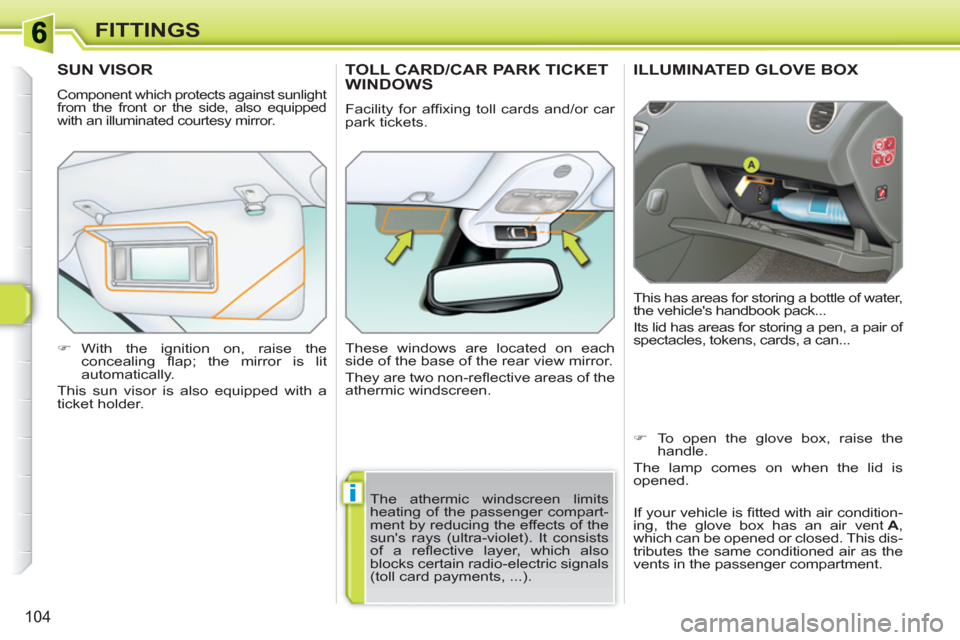
i
104
FITTINGS
ILLUMINATED GLOVE BOX
This has areas for storing a bottle of water,
the vehicle's handbook pack...
Its lid has areas for storing a pen, a pair of
spectacles, tokens, cards, a can...
SUN VISOR
Component which protects against sunlight
from the front or the side, also equipped
with an illuminated courtesy mirror.
�)
With the ignition on, raise the
concealing fl ap; the mirror is lit
automatically.
This sun visor is also equipped with a
ticket holder.
TOLL CARD/CAR PARK TICKET WINDOWS
Facility for affi xing toll cards and/or car
park tickets.
These windows are located on each
side of the base of the rear view mirror.
They are two non-refl ective areas of the
athermic windscreen.
The athermic windscreen limits
heating of the passenger compart-
ment by reducing the effects of the
sun's rays (ultra-violet). It consists
of a refl ective layer, which also
blocks certain radio-electric signals
(toll card payments, ...).
�)
To open the glove box, raise the
handle.
The lamp comes on when the lid is
opened.
If your vehicle is fi tted with air condition-
ing, the glove box has an air vent A
,
which can be opened or closed. This dis-
tributes the same conditioned air as the
vents in the passenger compartment.
Page 118 of 336
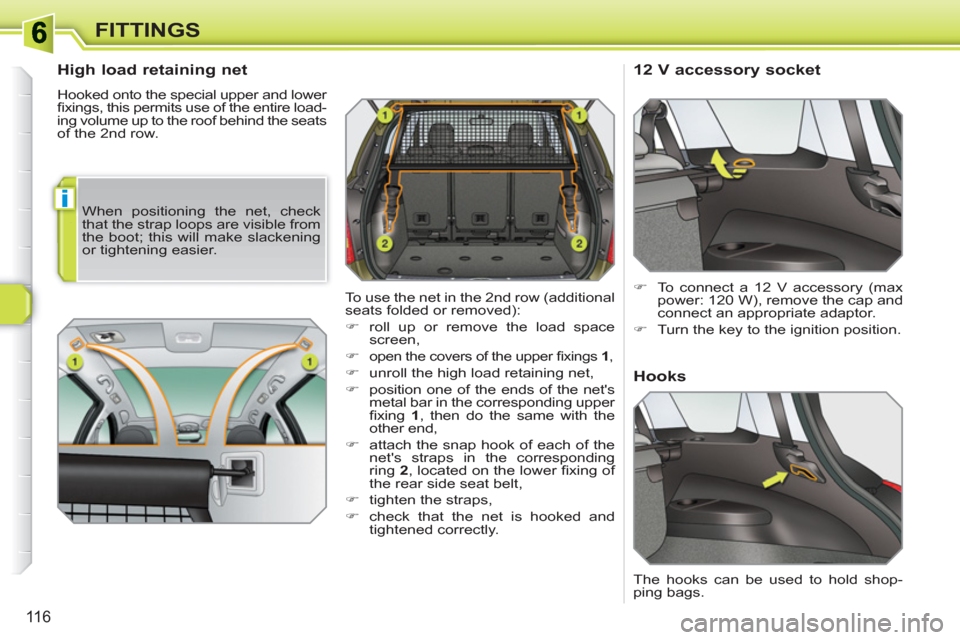
i
116
FITTINGS
High load retaining net
Hooked onto the special upper and lower
fi xings, this permits use of the entire load-
ing volume up to the roof behind the seats
of the 2nd row.
12 V accessory socket
�)
To connect a 12 V accessory (max
power: 120 W), remove the cap and
connect an appropriate adaptor.
�)
Turn the key to the ignition position.
To use the net in the 2nd row (additional
seats folded or removed):
�)
roll up or remove the load space
screen,
�)
open the covers of the upper fi xings 1
,
�)
unroll the high load retaining net,
�)
position one of the ends of the net's
metal bar in the corresponding upper
fi xing 1
, then do the same with the
other end,
�)
attach the snap hook of each of the
net's straps in the corresponding
ring 2
, located on the lower fi xing of
the rear side seat belt,
�)
tighten the straps,
�)
check that the net is hooked and
tightened correctly.
Hooks
When positioning the net, check
that the strap loops are visible from
the boot; this will make slackening
or tightening easier.
The hooks can be used to hold shop-
ping bags.
Page 129 of 336
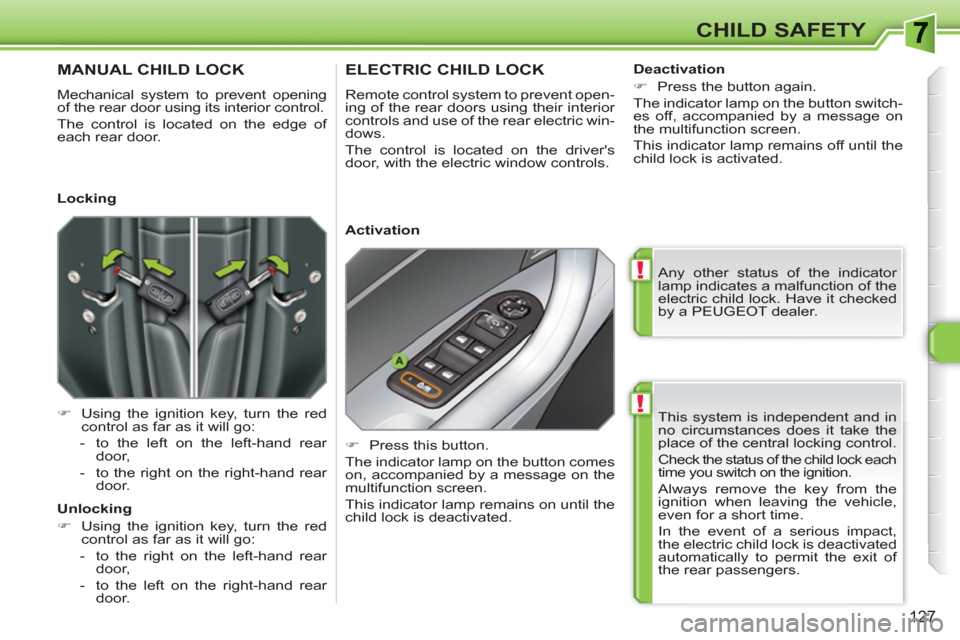
!
!
127
CHILD SAFETY
This system is independent and in
no circumstances does it take the
place of the central locking control.
Check the status of the child lock each
time you switch on the ignition.
Always remove the key from the
ignition when leaving the vehicle,
even for a short time.
In the event of a serious impact,
the electric child lock is deactivated
automatically to permit the exit of
the rear passengers.
MANUAL CHILD LOCK
Mechanical system to prevent opening
of the rear door using its interior control.
The control is located on the edge of
each rear door.
�)
Using the ignition key, turn the red
control as far as it will go:
- to the left on the left-hand rear
door,
- to the right on the right-hand rear
door.
ELECTRIC CHILD LOCK
Remote control system to prevent open-
ing of the rear doors using their interior
controls and use of the rear electric win-
dows.
The control is located on the driver's
door, with the electric window controls.
�)
Press this button.
The indicator lamp on the button comes
on, accompanied by a message on the
multifunction screen.
This indicator lamp remains on until the
child lock is deactivated.
Locking
Unlocking
�)
Using the ignition key, turn the red
control as far as it will go:
- to the right on the left-hand rear
door,
- to the left on the right-hand rear
door.
Activation
Deactivation
�)
Press the button again.
The indicator lamp on the button switch-
es off, accompanied by a message on
the multifunction screen.
This indicator lamp remains off until the
child lock is activated.
Any other status of the indicator
lamp indicates a malfunction of the
electric child lock. Have it checked
by a PEUGEOT dealer.
Page 130 of 336
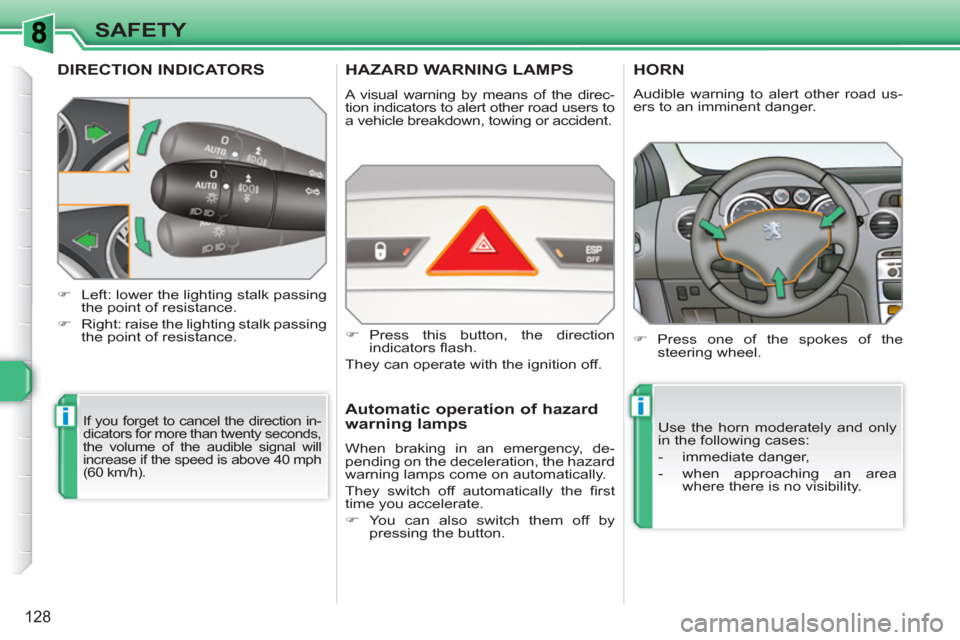
ii
128
SAFETY
DIRECTION INDICATORS
If you forget to cancel the direction in-
dicators for more than twenty seconds,
the volume of the audible signal will
increase if the speed is above 40 mph
(60 km/h).
�)
Left: lower the lighting stalk passing
the point of resistance.
�)
Right: raise the lighting stalk passing
the point of resistance.
HAZARD WARNING LAMPS
A visual warning by means of the direc-
tion indicators to alert other road users to
a vehicle breakdown, towing or accident.
�)
Press this button, the direction
indicators fl ash.
They can operate with the ignition off.
Automatic operation of hazard
warning lamps
When braking in an emergency, de-
pending on the deceleration, the hazard
warning lamps come on automatically.
They switch off automatically the fi rst
time you accelerate.
�)
You can also switch them off by
pressing the button.
HORN
�)
Press one of the spokes of the
steering wheel.
Use the horn moderately and only
in the following cases:
- immediate danger,
- when approaching an area
where there is no visibility.
Audible warning to alert other road us-
ers to an imminent danger.
Page 133 of 336
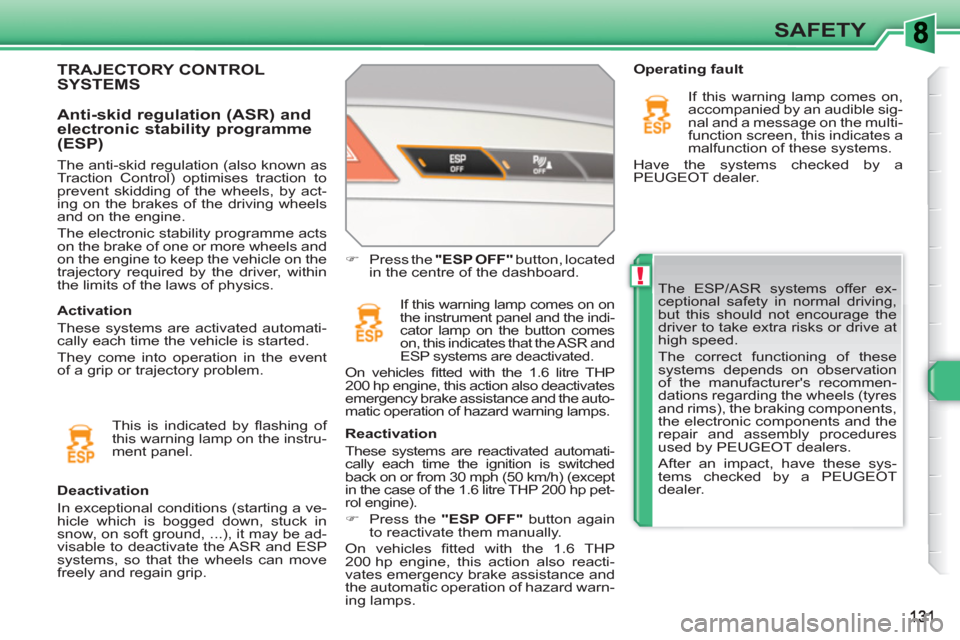
!
SAFETY
The ESP/ASR systems offer ex-
ceptional safety in normal driving,
but this should not encourage the
driver to take extra risks or drive at
high speed.
The correct functioning of these
systems depends on observation
of the manufacturer's recommen-
dations regarding the wheels (tyres
and rims), the braking components,
the electronic components and the
repair and assembly procedures
used by PEUGEOT dealers.
After an impact, have these sys-
tems checked by a PEUGEOT
dealer.
Deactivation
In exceptional conditions (starting a ve-
hicle which is bogged down, stuck in
snow, on soft ground, ...), it may be ad-
visable to deactivate the ASR and ESP
systems, so that the wheels can move
freely and regain grip.
�)
Press the "ESP OFF"
button, located
in the centre of the dashboard.
If this warning lamp comes on on
the instrument panel and the indi-
cator lamp on the button comes
on, this indicates that the ASR and
ESP systems are deactivated.
On vehicles fi tted with the 1.6 litre THP
200 hp engine, this action also deactivates
emergency brake assistance and the auto-
matic operation of hazard warning lamps.
Reactivation
These systems are reactivated automati-
cally each time the ignition is switched
back on or from 30 mph (50 km/h) (except
in the case of the 1.6 litre THP 200 hp pet-
rol engine).
�)
Press the "ESP OFF"
button again
to reactivate them manually.
On vehicles fi tted with the 1.6 THP
200 hp engine, this action also reacti-
vates emergency brake assistance and
the automatic operation of hazard warn-
ing lamps.
Operating fault
If this warning lamp comes on,
accompanied by an audible sig-
nal and a message on the multi-
function screen, this indicates a
malfunction of these systems.
Have the systems checked by a
PEUGEOT dealer.
TRAJECTORY CONTROLSYSTEMS
Activation
These systems are activated automati-
cally each time the vehicle is started.
They come into operation in the event
of a grip or trajectory problem.
Anti-skid regulation (ASR) and
electronic stability programme
(ESP)
This is indicated by fl ashing of
this warning lamp on the instru-
ment panel.
The anti-skid regulation (also known as
Traction Control) optimises traction to
prevent skidding of the wheels, by act-
ing on the brakes of the driving wheels
and on the engine.
The electronic stability programme acts
on the brake of one or more wheels and
on the engine to keep the vehicle on the
trajectory required by the driver, within
the limits of the laws of physics.
Page 134 of 336
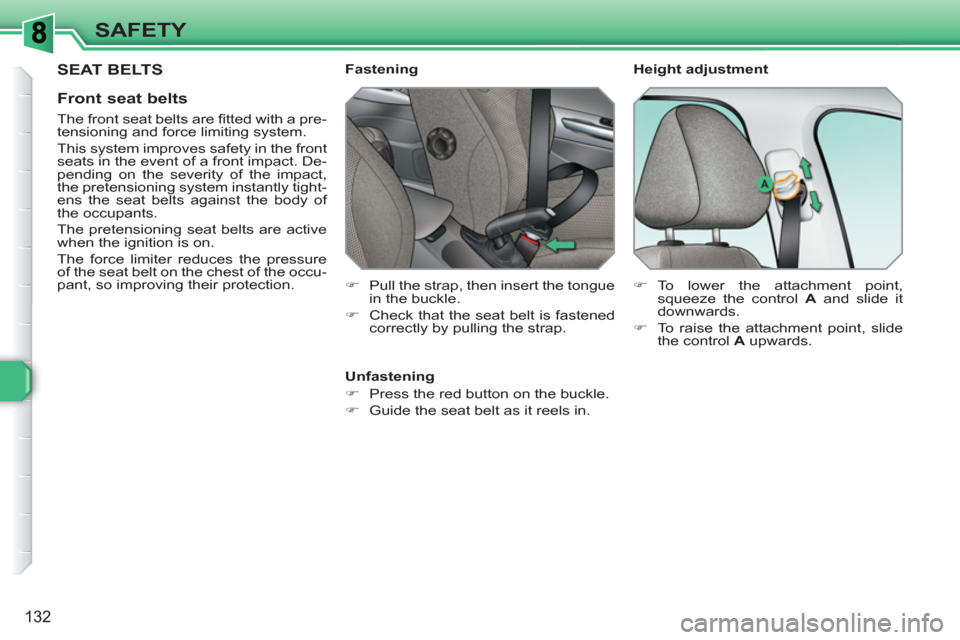
132
SAFETY
SEAT BELTS
Front seat belts
The front seat belts are fi tted with a pre-
tensioning and force limiting system.
This system improves safety in the front
seats in the event of a front impact. De-
pending on the severity of the impact,
the pretensioning system instantly tight-
ens the seat belts against the body of
the occupants.
The pretensioning seat belts are active
when the ignition is on.
The force limiter reduces the pressure
of the seat belt on the chest of the occu-
pant, so improving their protection.
Fastening
Unfastening
�)
Press the red button on the buckle.
�)
Guide the seat belt as it reels in.
Height adjustment
�)
Pull the strap, then insert the tongue
in the buckle.
�)
Check that the seat belt is fastened
correctly by pulling the strap.
�)
To lower the attachment point,
squeeze the control A
and slide it
downwards.
�)
To raise the attachment point, slide
the control A
upwards.
Page 135 of 336
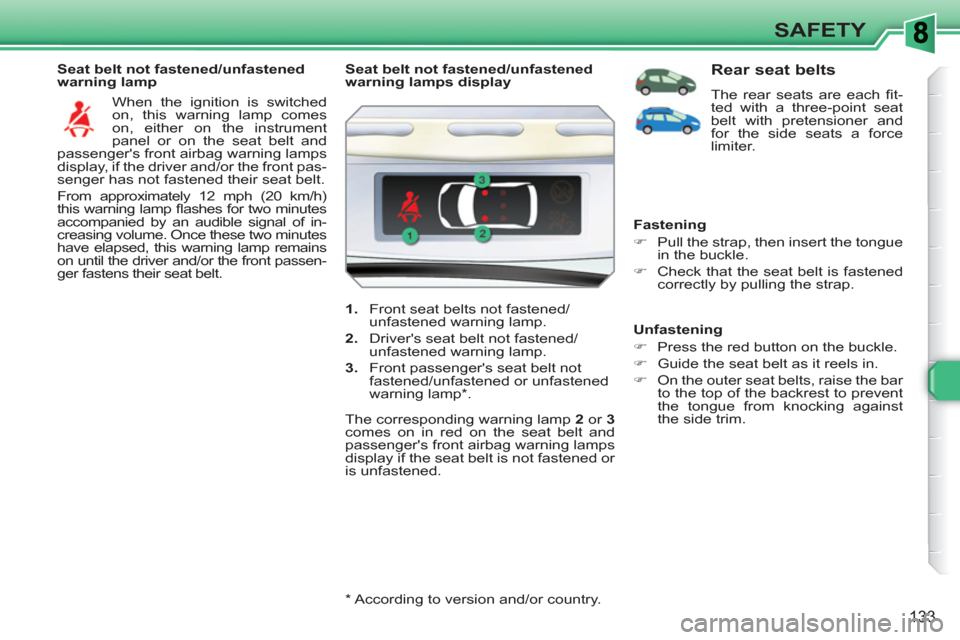
133
SAFETY
Seat belt not fastened/unfastened
warning lamp
When the ignition is switched
on, this warning lamp comes
on, either on the instrument
panel or on the seat belt and
passenger's front airbag warning lamps
display, if the driver and/or the front pas-
senger has not fastened their seat belt.
From approximately 12 mph (20 km/h)
this warning lamp fl ashes for two minutes
accompanied by an audible signal of in-
creasing volume. Once these two minutes
have elapsed, this warning lamp remains
on until the driver and/or the front passen-
ger fastens their seat belt.
*
According to version and/or country.
Seat belt not fastened/unfastened
warning lamps display
1.
Front seat belts not fastened/
unfastened warning lamp.
2.
Driver's seat belt not fastened/
unfastened warning lamp.
3.
Front passenger's seat belt not
fastened/unfastened or unfastened
warning lamp * .
The corresponding warning lamp 2
or 3
comes on in red on the seat belt and
passenger's front airbag warning lamps
display if the seat belt is not fastened or
is unfastened.
Rear seat belts
The rear seats are each fi t-
ted with a three-point seat
belt with pretensioner and
for the side seats a force
limiter.
Fastening
�)
Pull the strap, then insert the tongue
in the buckle.
�)
Check that the seat belt is fastened
correctly by pulling the strap.
Unfastening
�)
Press the red button on the buckle.
�)
Guide the seat belt as it reels in.
�)
On the outer seat belts, raise the bar
to the top of the backrest to prevent
the tongue from knocking against
the side trim.